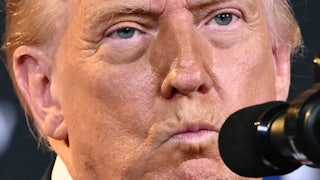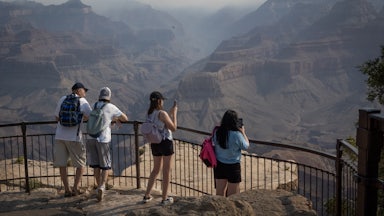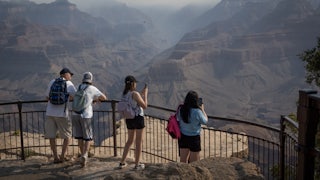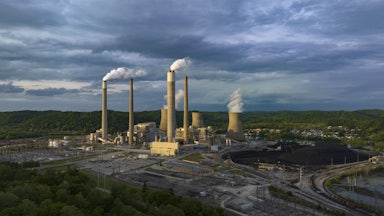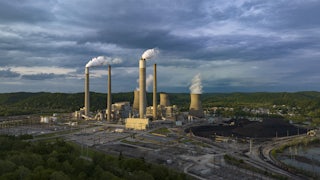If you didn’t know better, you’d think from listening to Donald Trump and his associates that they’ve developed a wholesome interest, one that hits many of us as we get older: birds.
During a recent visit to his golf course in Turnberry, Scotland—and seated beside U.K. Prime Minister Keir Starmer—the president launched into a rant about how windmills are “a disaster” that “kill all your birds.” And he’s got his administration on the case. “Wind projects are known to kill eagles,” Interior Secretary Doug Burgum tweeted last week, instructing his department to enforce the Bald and Golden Eagle Protection Act to protect the nationally symbolic birds of prey from windmills. Burgum also said he was ending “preferential treatment” for wind energy and announced an investigation into how turbines “might affect migratory bird populations.” He even halted offshore wind leasing and began canceling other wind projects.
This concern for the birds is certainly not based in a sincere commitment to conservation. As with most of Trump’s deeply held views, it’s at least partly rooted in a personal vendetta—not to mention detached from reality and undermined by his very own policies.
Trump has resented wind turbines since at least 2012, after learning of plans to build a wind farm near his golf course in Aberdeen, Scotland. His reasoning wasn’t entirely coherent. “They’re horrible looking structures,” he said in 2012. “They make noise, they kill birds by the thousands, they’re really destructive and I don’t care who the environmentalist is.” He sued to prevent the farm, lost, and has been seething and ranting about it ever since. (The wind farm was completed in 2018.)
He’s still sore about it. During his recent press conference with Starmer, Trump whined, “Look, wind is the most expensive form of energy. And it destroys the beauty of your fields and your plains and your waterways. Look out there, there’s no windmills. But if you look in another direction, you see windmills. When we go to Aberdeen, you’ll see some of the ugliest windmills you’ve ever seen.”
But he also gave the game away, adding, “And you can take a thousand times more energy out of a hole in the ground this big.” He spread his arms out—“This big. It’s called oil and gas. And you have it there, the North Sea, this big, that nobody would even see.” After all, Trump also shares with many other Republicans a hardcore, nihilistic commitment to fossil fuels, no matter the consequences (a commitment that is supported by millions in campaign donations).
So Trump is no ally to birds, except perhaps the tiny number who are harmed by wind turbines near his properties. But it’s worse than that: His policies are actually anti-bird.
Just four months ago, he called for gutting the very law that Burgum says he’ll enforce against windmills—the Bald and Golden Eagle Protection Act, which brought our national bird back from extinction—because he views it as burdensome to fossil fuel companies. Trump is also eviscerating protections for those particular birds, and many others, in at least two other ways, as The New York Times reported: weakening the Endangered Species Act by excluding habitat from the act’s protection, and diluting the Migratory Bird Treaty Act of 1918 by ceasing to penalize companies for accidentally killing birds.
Trump’s obsession with birds killed by wind turbines is also, like so much else that he complains about, not grounded in fact. Wind power kills very few birds compared to other threats: Turbines are responsible for less than 0.01 percent of human-caused bird deaths, putting them far behind domestic cats and buildings. Many more birds are killed by the fossil fuel industry that Trump tirelessly champions: oil pits, vehicles, fracking, and power lines. Birds fly into fossil fuel infrastructure just as they can fly into wind turbines, but the environmental effects of that industry harm them more: Coal destroys their habitat, while both coal and oil pollute their air. And the biggest threat to birds by far—sorry, Jonathan Franzen—is climate change, which is caused by the fossil fuel industry: The Audubon Society has estimated that two-thirds of American bird species could go extinct if global warming continues unchecked.
Trump sounds pretty insane when babbling about wind power, but he’s smart to talk about birds, because humans love birds. About three in 10 Americans engage in birdwatching, according to the U.S. Fish and Wildlife Service, whether in their own backyards or—in the case of some 44 million people—on outings a mile or more from their homes. Birding is also a sizable industry, contributing $279 billion to the economy.
Polling shows overwhelming bipartisan support for strengthening enforcement of the Endangered Species Act, rather than weakening it as Trump has done. But even when it comes to specific bird species, we agree that the government should protect them: A Pew survey last year of largely rural residents of 10 Western states found overwhelming, bipartisan support for the Bureau of Land Management’s efforts to protect the habitat of the Western sage-grouse—a flamboyant, and endangered, bird with speckled plumage that looks as if it’s wearing an ermine coat. Ninety-three percent of respondents said it was important, while 41 percent, including a third of Republicans, said it was “very important”; about 60 percent thought the agency’s protections for the sage-grouse weren’t enough, and that the government should do more. All that is notable because in Trump’s first term, he tried to weaken protections for the sage-grouse to allow oil and gas drilling in the bird’s preferred habitat, including on 10 million acres of public land—a move that courts have ruled against. (The Biden administration restored these protections just before Biden left office.)
Trump’s apparent preoccupation with bird protection is petty, self-serving, cynical, and hypocritical—all familiar characteristics for this president. While he works to ensure that the fossil fuel industry gets to kill any and all birds that might stand in its way, he’s decimating millions of species through climate change and weaponizing public concern for birds against renewable energy—which is the one hope for saving our natural world from the ravages of fossil fuels. And it’s all because he was powerless to stop a wind farm from going up near one of his tacky golf courses.

